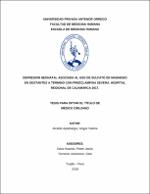| dc.contributor.advisor | Deza Huanes, Pedro Jesús | |
| dc.contributor.author | Alcalde Apaéstegui, Angye Valeria | |
| dc.creator | Alcalde Apaéstegui, Angye Valeria | |
| dc.date.accessioned | 2018-09-07T21:20:47Z | |
| dc.date.available | 2018-09-07T21:20:47Z | |
| dc.date.issued | 2018 | |
| dc.identifier.uri | https://hdl.handle.net/20.500.12759/4284 | |
| dc.description.abstract | Objetivo: Nos propusimos determinar la asociación que existe entre el uso sulfato
de magnesio en gestantes con embarazos a término con Preeclampsia severa y la
depresión neonatal.
Material y métodos: Realizamos un estudio Casos y Controles retrospectivo en
base a registros de neonatos cuyo parto fue atendido en el servicio de Obstetricia
del Hospital Regional Docente de Cajamarca en el periodo enero a diciembre del
2017. Para establecer la relación entre los factores asociados a la exposición del
sulfato de magnesio (Sexo y edad del neonato, peso al nacer, edad gestante, IMC
gestante, creatinina gestante, tipo de parto, Apgar) y la depresión neonatal, se
empleó el análisis bivariado. A continuación, se realizó el análisis multivariado
utilizando regresión logística para analizar independencia de asociación.
Resultados: Se encontró como variable con significancia estadística a la
depresión neonatal y la exposición de sulfato de magnesio, 85 % de neonatos con
depresión estuvieron expuestos a MgSO 4 ≥ 12 horas y 64 % de neonatos sin depresión estuvieron expuestos a MgSO 4 < 12 horas. El análisis bivariado, muestra como variable estadísticamente significativa a la exposición de MgSO 4 (OR=10.07; p=0.001; IC 95% [3.86 – 26.29]). En el análisis multivariado se
demuestra que son factores independientemente asociados a la depresión
neonatal: el no uso de Sulfato de Magnesio (OR=30.54; p=0.001; IC 95% [3.88240.25]) y la exposición al sulfato menor de 12 horas (OR= 0.005; p=0.001; IC 95% [0.001-0.048]).
Conclusión: Existe asociación entre la depresión neonatal y el tiempo de
exposición a sulfato de magnesio. | es_PE |
| dc.description.abstract | Objective: To determine the association that exists between the use of
magnesium sulphate in pregnant women with full term pregnancies with severe
pre-eclampsia and neonatal depression.
Material and methods: Case-control and retrospective study based on records of
neonates whose delivery was attended in the Obstetrics service of the Regional
Teaching Hospital of Cajamarca in the period January to December 2017. To
establish the relationship between the factors associated with the exposure of
magnesium sulfate (Sex and age of the newborn, birth weight, gestating age,
pregnant BMI, pregnant creatinine, type of delivery, Apgar) and neonatal
depression, bivariate analysis was used. Next, multivariate analysis was performed
using logistic regression to analyze independence of association.
Results: As a variable with statistical significance, neonatal depression and
exposure to magnesium sulfate were found, 85% of neonates with depression
were exposed to MgSO4 ≥ 12 hours and 64% of neonates without depression were
exposed to MgSO4 <12 hours. The bivariate analysis shows as a statistically
significant variable the MgSO4 exposure (OR = 10.07, p = 0.001, 95% CI [3.86 -
26.29]). In the multivariate analysis, it is shown that they are factors independently
associated with neonatal depression: the non-use of Magnesium Sulphate (OR =
30.54, p = 0.001, 95% CI [3.88-240.25]) and sulfate exposure less than 12 hours
(OR = 0.005, p = 0.001, 95% CI [0.001-0.048]).
Conclusion: There is an association between neonatal depression and exposure
to magnesium sulfate. | en_US |
| dc.description.uri | Tesis | es_PE |
| dc.format | application/pdf | es_PE |
| dc.language.iso | spa | es_PE |
| dc.publisher | Universidad Privada Antenor Orrego | es_PE |
| dc.relation.ispartofseries | T_MED.HUMA_2416 | |
| dc.rights | info:eu-repo/semantics/openAccess | es_PE |
| dc.rights.uri | https://creativecommons.org/licenses/by/4.0/ | es_PE |
| dc.source | Universidad Privada Antenor Orrego | es_PE |
| dc.source | Repositorio Institucional - UPAO | es_PE |
| dc.subject | Depresión neonatal | es_PE |
| dc.subject | Sulfato de magnesio | es_PE |
| dc.title | Depresión neonatal asociada al uso de sulfato de magnesio en gestantes a término con preeclampsia severa. Hospital Regional de Cajamarca 2017 | es_PE |
| dc.type | info:eu-repo/semantics/bachelorThesis | es_PE |
| thesis.degree.level | Título Profesional | es_PE |
| thesis.degree.grantor | Universidad Privada Antenor Orrego. Facultad de Medicina Humana | es_PE |
| thesis.degree.name | Médico Cirujano | es_PE |
| thesis.degree.discipline | Medicina Humana | es_PE |
| dc.subject.ocde | https://purl.org/pe-repo/ocde/ford#3.02.27 | es_PE |
| renati.type | https://purl.org/pe-repo/renati/type#tesis | es_PE |
| renati.level | https://purl.org/pe-repo/renati/level#tituloProfesional | es_PE |
| renati.discipline | 912016 | es_PE |
| dc.publisher.country | PE | es_PE |


